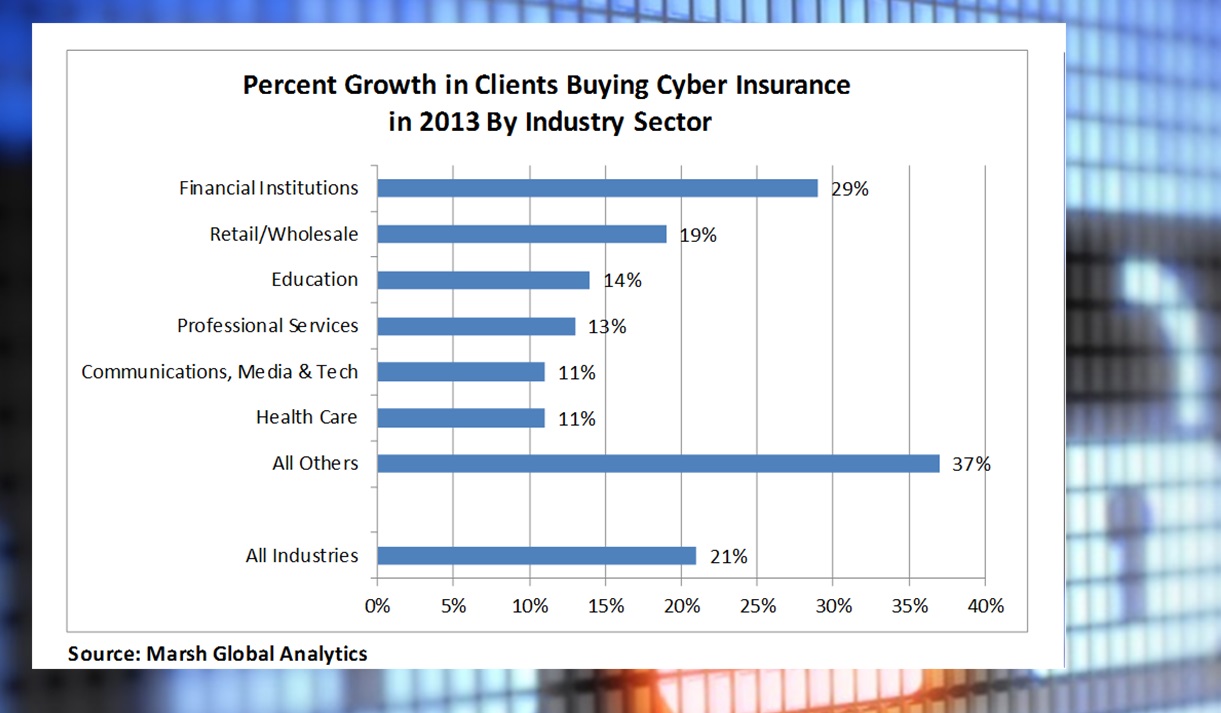In its latest report on benchmarking trends in the cyber insurance, broker Marsh reveals that while high-profile breaches in the retail sector may be one factor sparking demand, increases in insurance purchases were evident in all industry sectors.
Emerging sectors for cyber purchasing included manufacturing, power and utilities, and hospitality, Marsh said in its report, noting that board-level concerns and the realization that operations are increasing vulnerable to failure of technology are other factors fueling interest in the insurance.
Across all industries, the number of Marsh clients purchasing cyber insurance increased 21 percent, with buyers in data-rich sectors seeing the biggest jumps. Financial institutions buyers, for example, increased 29 percent, while retailer purchased grew by 19 percent.
The report, “Benchmarking Trends: Interest in Cyber Insurance Continues to Climb,” is a compilation of Marsh’s own customer data specific to the cyber coverage segment.
“What you are seeing is a continued awareness of cyber risks as well as a maturation or evolution of the product itself,” says Bob Parisi, Network Security and Privacy Practice leader for Marsh. “There have been several events that have occurred over the last few years that have continued to push demand for the coverage.”
The amount of limits purchased by individual companies also increased in 2013. More companies purchased cyber coverage with $100 million limits or more. The average limits purchased by companies with revenues more than $1 billion rose by 10 percent in 2013 to $28.2 million, with financial institutions purchasing the highest limits of $53.2 million on average—a 9 percent increase from 2012.
Across companies of all sizes (not just those with revenues of $1 billion of more), average limits were $11.5 million in 2013.
Parisi says the request for higher limits is a realization by all industries of their reliance on technology and the “totality” of their risks.
“Companies are looking beyond just privacy and at how technology or the failure of technology would impact their business. They are looking for more business expense or business interruption coverage and buying a broader bucket of coverage,” says Parisi.
Clients are also moved to purchase coverage by the value-added services that come with most cyber policies now, particularly among the small- to mid-market segment that doesn’t have a sophisticated cyber risk or crisis management plan, says Parisi. The Marsh report noted that cyber policies are much broader now than several years ago, and in addition to pre-and post-loss services, many policies now cover third party losses as well as business interruption.
Parisi says competition has influenced this coverage trend, as it has also kept pricing for the coverage down. Renewal rates remained stable in 2013, according to the report, and average increases were typically small— ranging between 2 and 3 percent compared to 2012.
“The [money] spent on a policy in 2014 gets you a lot more coverage than what you would have spent for coverage in 2005. You are getting a lot more for your dollar now,” he says.
The significant increase in interest for coverage, as well as new business that was initiated during the third quarter of 2013 as a result of high profile cyber events, has continued and even accelerated so far in 2014, noted the Marsh report.
Parisi says he expects demand and the uptick in coverage buying to continue throughout this year. However, Parisi acknowledges full market penetration of cyber coverage is still a way off. When that does occur, it will be because the coverage will have evolved to more specifically address different industry exposures, he believes.
“I think what we are going to see is cyber becoming less of a discretionary purchase and more of a structural or elemental part of a client’s risk transfer approach,” says Parisi.
The benchmarking report also includes information on changes in cyber liability prices per million dollars of coverage and total capacity available for various industry sectors.
(O’Connor is the Editor of MyNewMarkets.com, a sister publication of Carrier Management)






















 The Future of Knowledge in Insurance: From Training to AI-Powered Productivity
The Future of Knowledge in Insurance: From Training to AI-Powered Productivity  Viewpoint: Mapping Evolving Regulatory Terrain for MGAs, MGUs and Other DUAEs
Viewpoint: Mapping Evolving Regulatory Terrain for MGAs, MGUs and Other DUAEs  Chubb, The Hartford, Liberty and Travelers Team Up on Surety Tech Co. Launch
Chubb, The Hartford, Liberty and Travelers Team Up on Surety Tech Co. Launch  Truckers Who Fail English Tests Are Pulled Off Roads in Crackdown
Truckers Who Fail English Tests Are Pulled Off Roads in Crackdown 




